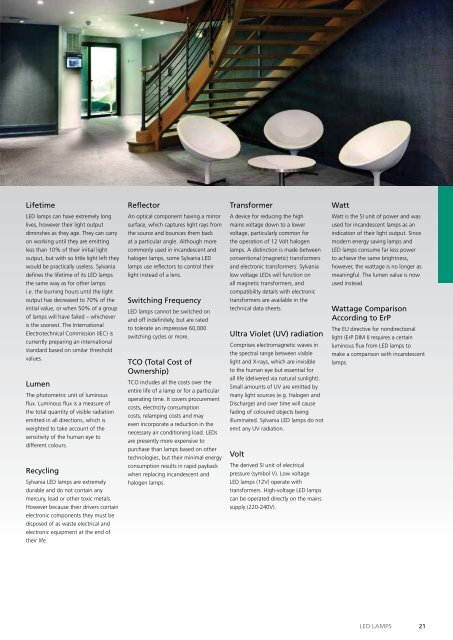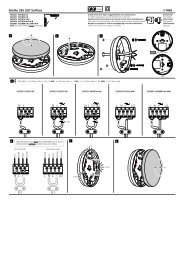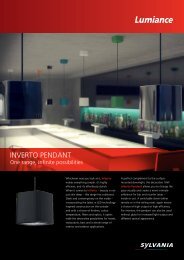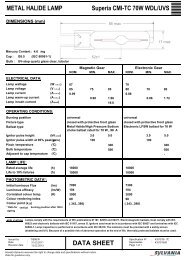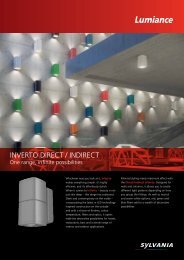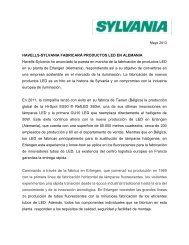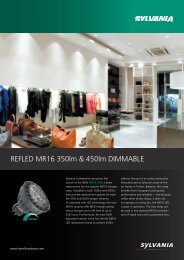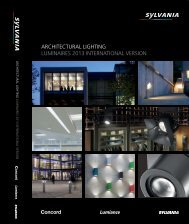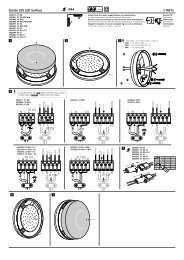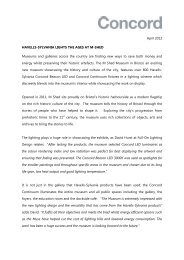LED Lamps - Havells-Sylvania
LED Lamps - Havells-Sylvania
LED Lamps - Havells-Sylvania
- No tags were found...
Create successful ePaper yourself
Turn your PDF publications into a flip-book with our unique Google optimized e-Paper software.
LifetimeReflectorTransformerWatt<strong>LED</strong> lamps can have extremely longAn optical component having a mirrorA device for reducing the highWatt is the SI unit of power and waslives, however their light outputsurface, which captures light rays frommains voltage down to a lowerused for incandescent lamps as andiminshes as they age. They can carrythe source and bounces them backvoltage, particularly common forindication of their light output. Sinceon working until they are emittingat a particular angle. Although morethe operation of 12 Volt halogenmodern energy saving lamps andless than 10% of their initial lightcommonly used in incandescent andlamps. A distinction is made between<strong>LED</strong> lamps consume far less poweroutput, but with so little light left theyhalogen lamps, some <strong>Sylvania</strong> <strong>LED</strong>conventional (magnetic) transformersto achieve the same brightness,would be practically useless. <strong>Sylvania</strong>lamps use reflectors to control theirand electronic transformers. <strong>Sylvania</strong>however, the wattage is no longer asdefines the lifetime of its <strong>LED</strong> lampslight instead of a lens.low voltage <strong>LED</strong>s will function onmeaningful. The lumen value is nowthe same way as for other lamps:all magnetic transformers, andused instead.i.e. the burning hours until the lightoutput has decreased to 70% of theinitial value, or when 50% of a groupof lamps will have failed – whicheveris the soonest. The InternationalElectrotechnical Commission (IEC) iscurrently preparing an internationalstandard based on similar thresholdvalues.LumenThe photometric unit of luminousflux. Luminous flux is a measure ofthe total quantity of visible radiationemitted in all directions, which isweighted to take account of thesensitivity of the human eye todifferent colours.Recycling<strong>Sylvania</strong> <strong>LED</strong> lamps are extremelydurable and do not contain anySwitching Frequency<strong>LED</strong> lamps cannot be switched onand off indefinitely, but are ratedto tolerate an impressive 60,000switching cycles or more.TCO (Total Cost ofOwnership)TCO includes all the costs over theentire life of a lamp or for a particularoperating time. It covers procurementcosts, electricity consumptioncosts, relamping costs and mayeven incorporate a reduction in thenecessary air conditioning load. <strong>LED</strong>sare presently more expensive topurchase than lamps based on othertechnologies, but their minimal energyconsumption results in rapid paybackwhen replacing incandescent andhalogen lamps.compatibility details with electronictransformers are available in thetechnical data sheets.Ultra Violet (UV) radiationComprises electromagnetic waves inthe spectral range between visiblelight and X-rays, which are invisibleto the human eye but essential forall life (delivered via natural sunlight).Small amounts of UV are emitted bymany light sources (e.g. Halogen andDischarge) and over time will causefading of coloured objects beingilluminated. <strong>Sylvania</strong> <strong>LED</strong> lamps do notemit any UV radiation.VoltThe derived SI unit of electricalpressure (symbol V). Low voltage<strong>LED</strong> lamps (12V) operate withtransformers. High-voltage <strong>LED</strong> lampsWattage ComparisonAccording to ErPThe EU directive for nondirectionallight (ErP DIM I) requires a certainluminous flux from <strong>LED</strong> lamps tomake a comparison with incandescentlamps.mercury, lead or other toxic metals.can be operated directly on the mainsHowever because their drivers containsupply (220-240V).electronic components they must bedisposed of as waste electrical andelectronic equipment at the end oftheir life.<strong>LED</strong> LAMPS21


